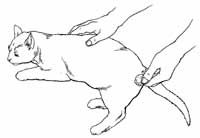 “© Publications International, Ltd. Step 3
“© Publications International, Ltd. Step 3
Dealing with a cat that has an abscess, or a localized infection filled with pus, can be difficult since it’s not always clear what’s wrong. The body creates walls around these wounds, and the pus collects within the confines of the walls.
Abscesses in cats are usually caused by bite wounds or scratches, and may be multiple when they occur. The infection results from bacteria carried on the teeth or claws of the attacking animal, which enters the skin through the bite or scratch. Most abscesses will be located around the neck, front legs, or the tail and rump area. Many times owners fail to realize the cat has been bitten. Some of the signs to look for are soft, painful swelling, foul-smelling discharge from an open wound, lethargy, and a loss of appetite. If you’re ever in doubt, call your veterinarian before proceeding.
To properly treat a cat with an abscess, follow the cat care tips listed below:
Step 1: Clip the hair around the abscess area.
Step 2: If the abscess is draining, proceed to Step 3. If not, apply hot, moist compresses for 20-minute periods two or three times a day until the abscess starts draining.
Step 3: Thoroughly clean the area with a mild saline solution or just warm water two or three times a day. Do not use any other antiseptic. These compresses will also help to prevent a scab from forming.
Step 4: If the cat stops eating, or the abscess does not stop draining foul-smelling material within 48 hours, or the area of involvement is very large, transport the cat to the veterinarian as soon as possible.
© Publications International, Ltd.


